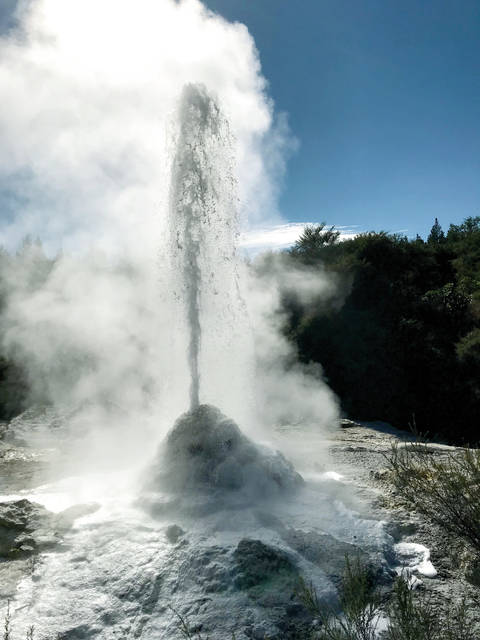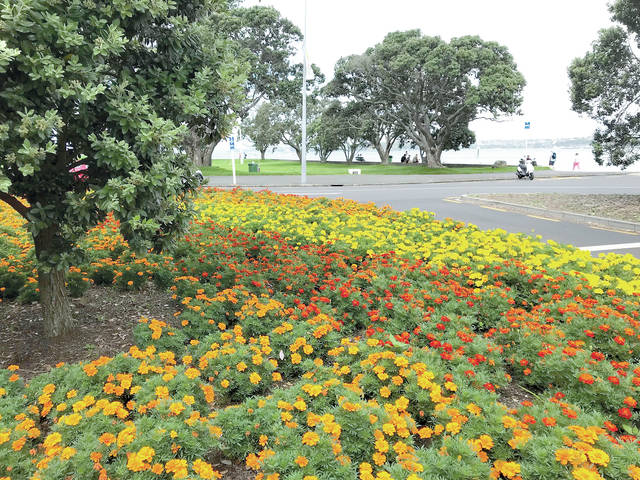Folks in New Zealand are a lot like us in Hawaii.
High food costs are a headache these days no matter where you live. As a result, yards and lanai offer a prime opportunity to help cut food costs. You can do it by planting vegetables and flowers.
And if you’re going to a have a top-notch garden, it’s time to plan the planting layout.
By designing a combination, you can have an attractive spot that will produce cut flowers and fresh vegetables. Both require regular fertilization and spraying for insects and disease, so they are a natural together.
In selecting the plot, remember most annuals and vegetables must have a full six to eight hours of sun per day.
Next comes the vexing problem of what to plant. Choosing plants by heights is one problem-solving approach. Some taller annuals for the back areas of the garden are cleome and sunflower. Some taller vegetables to try are Hawaiian super sweet corn, trellis UH tomatoes and Manoa wonder beans.
In the center rows and toward the front, consider medium-height plants. Tuberose, blue salvia, tall ageratum, giant dahlias, red salvia and gypsophilla are examples. Vegetables include peppers, squash and Waimanalo long eggplant. For low edging, you might use allysum, petunias, verbena, dwarf phlox or some of the dwarf nasturtiums. Waianae strain kai choi, won bok, Manoa lettuce and parsley are good varieties of vegetables.
With up to 100 annuals and vegetables from which to choose, it shouldn’t be a problem to fill the garden with many kinds of colorful and useful plants.
You can try your hand at success by using the organic approach or the conventional approach, or a combination.
Organic gardening differs from conventional gardening mainly in areas of fertilization and pest control. The organic gardener uses organic materials and methods, whereas the conventional gardener will use a combination of all materials and methods shown to be safe, effective and not detrimental to himself or his environment.
Here are some steps to aid you in supplying your vegetable needs.
Select a plot of well-drained soil near a water supply. It should be close to the home for convenience but should not be shaded by tall buildings or trees. Enclosing the garden spot with a fence is usually profitable.
Many gardeners find it helpful to draw out on paper the location of each row and the crop or succession of crops to be planted.
Contact the University of Hawaii Master Gardener hotline in Kona or Hilo for information about vegetables suited to Hawaiian gardens, leading varieties, seed or plants needed, planting distances and depths, and best time for planting.
Since organic fertilizer and soil conditioning materials are slow-working in general, they should be mixed into the soil at least three weeks ahead of planting and the soil thoroughly prepared for the seed or transplants. Natural and organic materials that yield plant nutrients upon decomposition often are available for purchase either separately or in combination. These materials can be applied to the garden separately or combined, used in the compost pile or mixed with manure.
An advantage for using organic materials as fertilizers is that they contain many of the elements also needed by the plants in addition to nitrogen, phosphorus and potassium.
Besides the general amounts of micro nutrients found in most organic materials, certain ones are concentrated into such naturally occurring materials as gypsum (calcium and sulfur) and dolomite (calcium and magnesium).
Reducing the acidity of the soil is the primary purpose for using lime in the garden. However, liming materials also provide nutrients for plant use.
Calcium and magnesium are the two elements most commonly provided by lime. Lime to sweeten the soil should be applied only when the needs are established by a reliable soil test. Apply lime well in advance of the planting date, preferably two to three months before. Mix well with the soil and keep moist for best reaction.
In irrigating the garden, it is advisable to thoroughly wet the soil once a week unless sufficient rain falls. Thus, the soil will be moistened throughout the root zone. Light sprinklings everyday merely tend to wet the surface and encourage shallow root growth.
Use of organic materials such as soil conditioners and fertilizers tends to improve the ability of the soil to retain moisture. Also, a good garden mulch will conserve soil moisture.
A mulch is any material, usually organic, placed on the soil surface around the plants. Organic materials most commonly used for mulching are leaves, grass clippings, sawdust and weed shavings. Synthetic materials, such as plastic sheeting, have been used quite often in recent years. Avoid placing mulches against the stems of plants or it can create disease issues.
Among the benefits of a mulch are that it conserves soil moisture, conserves nutrients, reduces soil erosion, reduces weed growth and provides a barrier between fruit and soil. It also moderates soil temperature.
At the end of the garden season, the mulch can be removed and composted or cut into the garden soil. Most mulch is woody and should have manure or other rich organic fertilizer applied with it when cutting into the soil.
During periods when infestations of various garden pests are high, control by natural means becomes very difficult. However, the following practices will help to reduce losses.
Plant resistant varieties. Select peat-free transplants. For cutworms, place a cardboard collar around plant stems at ground level. Spade your garden early so vegetation has time to rot before planting. Clean crop refuse early. Keep out weeds that harbor insects and diseases. Hand pick insects such as caterpillars when inspecting your garden, where possible.
Water in the morning so plants are not wet at night.
Dispose of severely diseased plants before they contaminate others.
Marigolds, when planted as cover crops, tend to reduce some kinds of nematodes. But the use of marigolds to repel nematodes is not a proven effective control. A good garden mulch tends to reduce damage caused by nematodes.
Many organic gardeners approve of and use sprays and other preparations containing naturally occurring materials. Pyrethrin, rotenone, neem and nicotine are examples of natural poisons from plant parts. These give some control to some insects under certain conditions.
Natural predators should be encouraged wherever possible.
Suitable materials for growing vegetables the organic way are not always easy to locate. Garden supply stores carry many products, especially seeds and equipment that can be used by the organic enthusiast. However, for the difficult-to-find items, you might have to order from specialty businesses dealing in organic gardening supplies.


